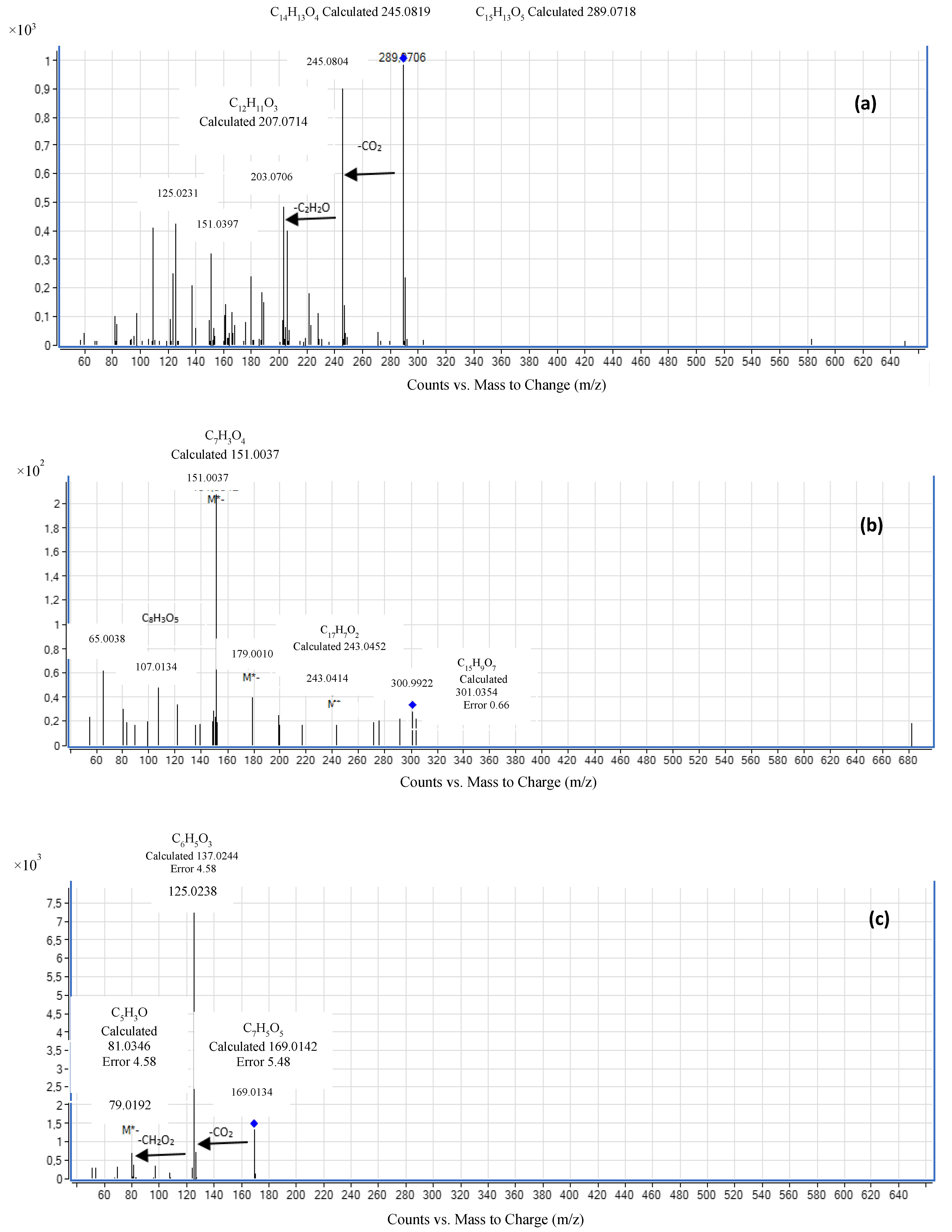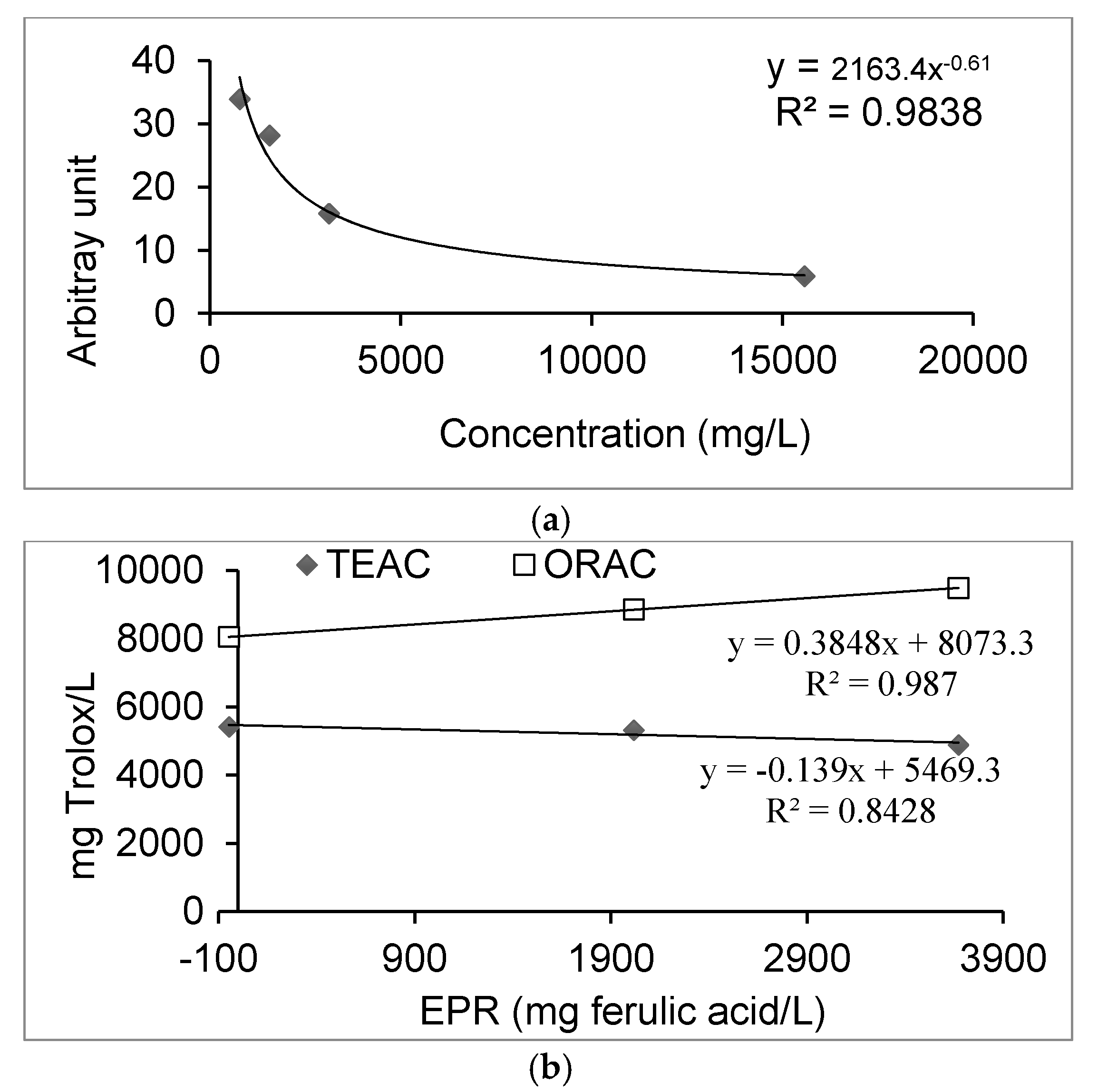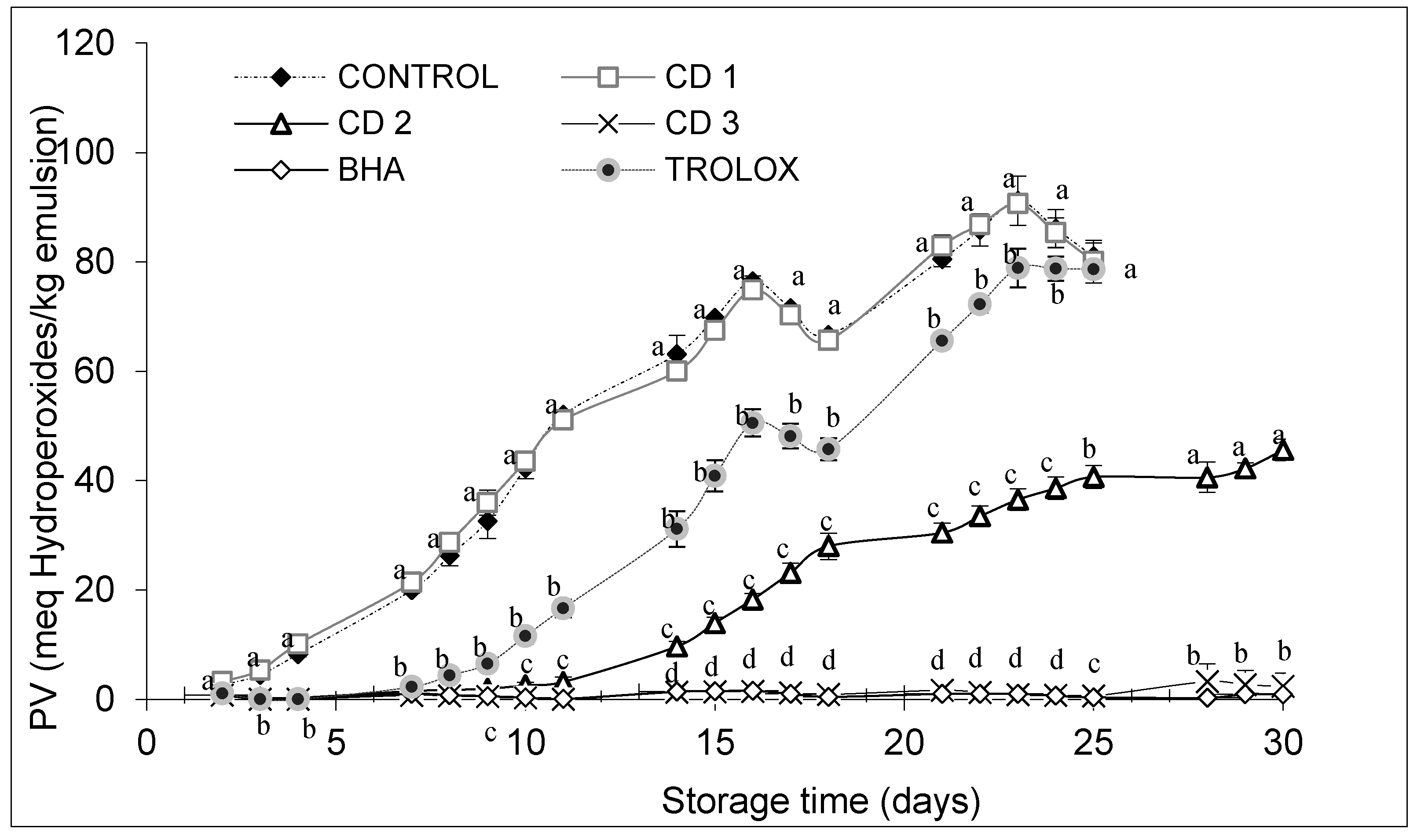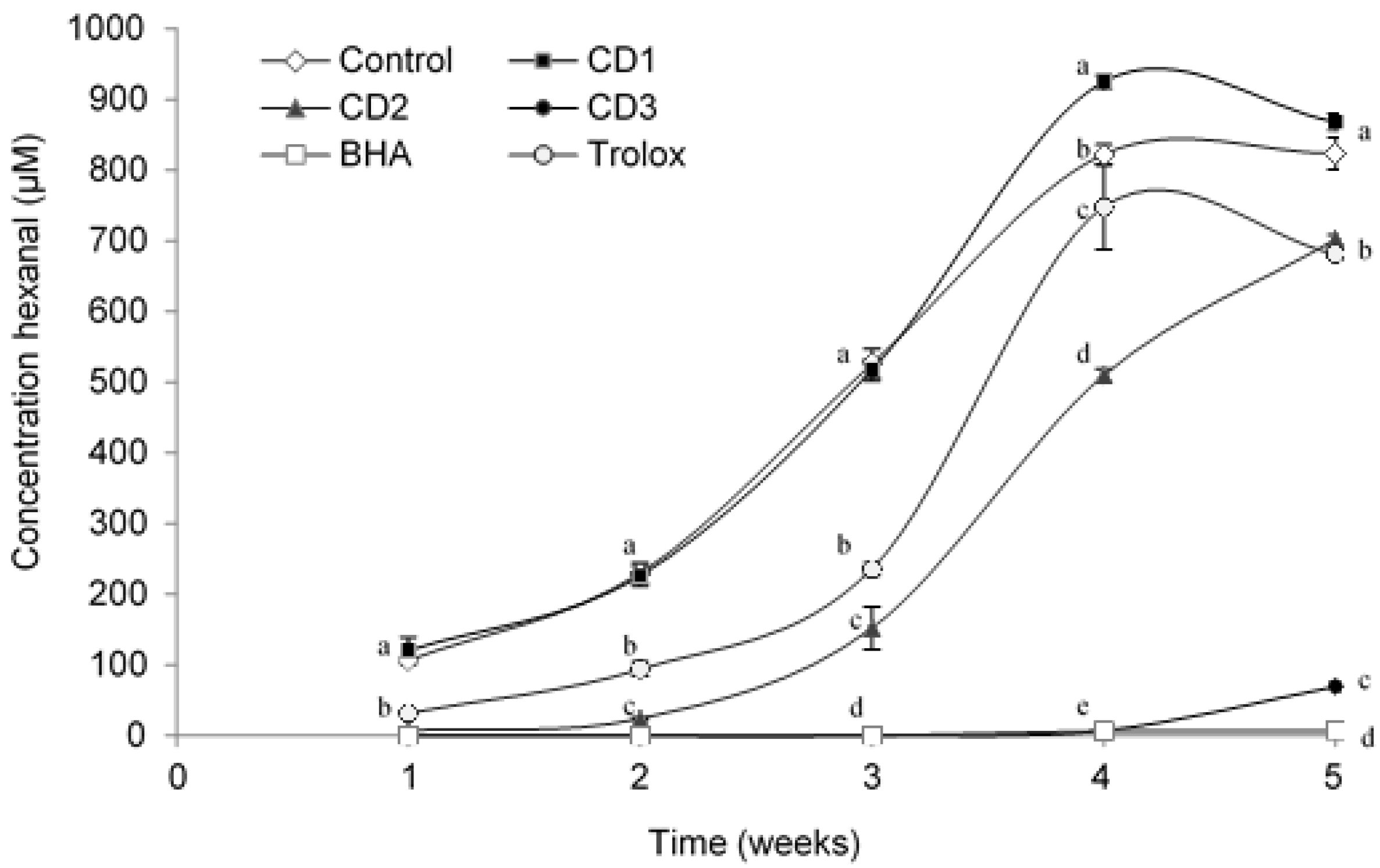Effect of Leaves of Caesalpinia decapetala on Oxidative Stability of Oil-in-Water Emulsions
Abstract
:1. Introduction
2. Materials and Methods
2.1. Plant Material
2.2. Chemicals
2.3. Sample Extraction
2.4. Determination of Total Polyphenols and Total Flavonoid Content
2.5. HPLC Analysis of the Extracts
2.6. Radical Scavenging Determination
2.7. Radical Scavenging by Electron Paramagnetic Resonance Assay
2.8. Preparation of Stripped Sunflower Oil
2.9. Preparation of Emulsions
2.10. Determination of Peroxide Value
2.11. Determination of Secondary Oxidation by TBARS for Emulsions
2.12. Headspace Volatile Analysis of Emulsions
2.13. Statistical Analysis
3. Results
3.1. Total Phenolic and Total Flavonoid Content
3.2. Radical Scavenging Activity
3.3. EPR (Electron Paramagnetic Resonance) Study
3.4. Effect of CD (Caesalpinia decapetala) Extract on the Oxidative Stability of Emulsions
3.5. Headspace Volatile Analysis
4. Discussion
4.1. Total Phenolic and Total Flavonoid Content
4.2. Radical Scavenging Activity
4.3. EPR Study
4.4. Effect of CD Extract on Oxidative Stability of Emulsions
4.5. Headspace Volatile Analysis
5. Conclusions
Acknowledgments
Author Contributions
Conflicts of Interest
References
- Berton, C.; Ropers, M.H.; Viau, M.; Genot, C. Contribution of the interfacial layer to the protection of emulsified lipids against oxidation. J. Agric. Food Chem. 2011, 59, 5052–5061. [Google Scholar] [CrossRef] [PubMed]
- Laguerre, M.; Bayrasy, C.; Panya, A.; Weiss, J.; McClements, D.J.; Lecomte, J.; Decker, E.A.; Villeneuve, P. What makes good antioxidants in lipid-based systems? The next theories beyond the polar paradox. Crit. Rev. Food Sci. Nutr. 2015, 55, 183–201. [Google Scholar] [CrossRef] [PubMed]
- Formanek, Z.; Kerry, J.P.; Higgins, F.M.; Buckley, D.J. Addition of synthetic and natural antioxidants to α-tocopheryl acetate supplemented beef patties: Effects of antioxidants and packaging on lipid oxidation. Meat Sci. 2001, 58, 337–341. [Google Scholar] [CrossRef]
- Wang, L.; Gao, Y.; Li, J.; Subirade, M.; Song, Y.; Liang, L. Effect of resveratrol or ascorbic acid on the stability of α-tocopherol in O/W emulsions stabilized by whey protein isolate: Simultaneous encapsulation of the vitamin and the protective antioxidant. Food Chem. 2016, 196, 466–474. [Google Scholar] [CrossRef] [PubMed]
- Brewer, M.S. Natural Antioxidants: Sources, Compounds, Mechanisms of Action, and Potential Applications. Compr. Rev. Food Sci. Food Saf. 2011, 10, 221–247. [Google Scholar] [CrossRef]
- Jimenez-Zamora, A.; Delgado-Andrade, C.; Rufian-Henares, J.A. Antioxidant capacity, total phenols and color profile during the storage of selected plants used for infusion. Food Chem. 2016, 199, 339–346. [Google Scholar] [CrossRef] [PubMed]
- Chammem, N.; Saoudi, S.; Sifaoui, I.; Sifi, S.; de Person, M.; Abderraba, M.; Moussa, F.; Hamdi, M. Improvement of vegetable oils quality in frying conditions by adding rosemary extract. Ind. Crops Prod. 2015, 74, 592–599. [Google Scholar] [CrossRef]
- Wei, X.H.; Yang, S.J.; Liang, N.; Hu, D.Y.; Jin, L.H.; Xue, W.; Yang, S. Chemical constituents of Caesalpinia decapetala (Roth) alston. Molecules 2013, 18, 1325–1336. [Google Scholar] [CrossRef] [PubMed]
- Kiem, P.V.; Minh, C.V.; Huong, H.T.; Lee, J.J.; Kim, Y.H. Caesaldecan, a cassane diterpenoid from the leaves of Caesalpinia decapetala. Chem. Pharm. Bull. (Tokyo) 2005, 53, 428–430. [Google Scholar] [CrossRef] [PubMed]
- Pawar, C.; Surana, S. Antioxidant Properties of the Methanol Extract of the Wood and Pericarp of Caesalpinia decapetala. J. Young Pharm. 2010, 2, 45–49. [Google Scholar] [CrossRef] [PubMed]
- Pawar, C.R.; Surana, S.J. Optimizing conditions for gallic acid extraction from Caesalpinia decapetala wood. Pak. J. Pharm. Sci. 2010, 23, 423–425. [Google Scholar] [PubMed]
- Gallego, M.G.; Rodríguez, T.; Rodríguez, I.; Almajano, M.P. Analytical Characterization of Polyphenols from Tara and Caesalpinia decapetala as Stabilizers of O/W Emulsions. J. Food Sci. 2016, 81, C2676–C2685. [Google Scholar] [CrossRef] [PubMed]
- Skowyra, M.; Gallego, M.G.; Segovia, F.; Almajano, M.P. Antioxidant Properties of Artemisia annua Extracts in Model Food Emulsions. Antioxidants 2014, 3, 116–128. [Google Scholar] [CrossRef] [PubMed] [Green Version]
- Zhishen, J.; Mengcheng, T.; Jianming, W. The determination of flavonoid contents in mulberry and their scavenging effects on superoxide radicals. Food Chem. 1999, 64, 555–559. [Google Scholar] [CrossRef]
- Gallego, M.G.; Gordon, M.H.; Segovia, F.J.; Skowyra, M.; Almajano, M.P. Antioxidant Properties of Three Aromatic Herbs (Rosemary, Thyme and Lavender) in Oil-in-Water Emulsions. J. Am. Oil Chem. Soc. 2013, 90, 1559–1568. [Google Scholar] [CrossRef]
- Aini, N.; Azman, M.; Gallego, M.G.; Fajari, L.; Resources, N.; Faculty, E.; Tun, L.; Abourashed, E.A. The Effect of Convolvulus arvensis Dried Extract as a Potential Antioxidant in Food Models. Antioxidants 2015, 4, 170–184. [Google Scholar] [Green Version]
- Yoshida, H.; Kajimoto, G.; Emura, S. Antioxidant effects of d-tocopherols at different concentrations in oils during microwave heating. J. Am. Oil Chem. Soc. 1993, 70, 989–995. [Google Scholar] [CrossRef]
- Firestone, D. Official Methods and Recommended Practices of the American Oil Chemists’ Society, 5th ed.; AOAC Press: Champaign, IL, USA, 1997. [Google Scholar]
- Baratto, M.C.; Tattini, M.; Galardi, C.; Pinelli, P.; Romani, A.; Visioli, F.; Basosi, R.; Pogni, R. Antioxidant activity of galloyl quinic derivatives isolated from P. lentiscus leaves. Free Radic. Res. 2003, 37, 405–412. [Google Scholar] [CrossRef] [PubMed]
- Laguerre, M.; Lecomte, J.; Villeneuve, P. Evaluation of the ability of antioxidants to counteract lipid oxidation: Existing methods, new trends and challenges. Prog. Lipid Res. 2007, 46, 244–282. [Google Scholar] [CrossRef] [PubMed]
- Srinivasan, R.; Chandrasekar, M.J.N.; Nanjan, M.J.; Suresh, B. Antioxidant activity of Caesalpinia digyna root. J. Ethnopharmacol. 2007, 113, 284–291. [Google Scholar] [CrossRef] [PubMed]
- Bhat, P.B.; Hegde, S.; Upadhya, V.; Hegde, G.R.; Habbu, P.V.; Mulgund, G.S. Evaluation of wound healing property of Caesalpinia mimosoides Lam. J. Ethnopharmacol. 2016, 193, 712–724. [Google Scholar] [CrossRef] [PubMed]
- Kaviarasan, S.; Naik, G.H.; Gangabhagirathi, R.; Anuradha, C.V.; Priyadarsini, K.I. In vitro studies on antiradical and antioxidant activities of fenugreek (Trigonella foenum graecum) seeds. Food Chem. 2007, 103, 31–37. [Google Scholar] [CrossRef]
- Zanin, J.L.B.; de Carvalho, B.A.; Martineli, P.S.; dos Santos, M.H.; Lago, J.H.G.; Sartorelli, P.; Viegas, C.; Soares, M.G. The genus Caesalpinia L. (Caesalpiniaceae): Phytochemical and pharmacological characteristics. Molecules 2012, 17, 7887–7902. [Google Scholar] [CrossRef] [PubMed] [Green Version]
- Power, O.; Jakeman, P.; FitzGerald, R.J. Antioxidative peptides: Enzymatic production, in vitro and in vivo antioxidant activity and potential applications of milk-derived antioxidative peptides. Amino Acids 2013, 44, 797–820. [Google Scholar] [CrossRef] [PubMed]
- Floegel, A.; Kim, D.-O.; Chung, S.-J.; Koo, S.I.; Chun, O.K. Comparison of ABTS/DPPH assays to measure antioxidant capacity in popular antioxidant-rich US foods. J. Food Compos. Anal. 2011, 24, 1043–1048. [Google Scholar] [CrossRef]
- Gan, R.-Y.; Xu, X.-R.; Song, F.-L.; Kuang, L.; Li, H.-B. Antioxidant activity and total phenolic content of medicinal plants associated with prevention and treatment of cardiovascular and cerebrovascular diseases. J. Med. Plant Res. 2010, 4, 2438–2444. [Google Scholar]
- Chambi, F.; Chirinos, R.; Pedreschi, R.; Betalleluz-Pallardel, I.; Debaste, F.; Campos, D. Antioxidant potential of hydrolyzed polyphenolic extracts from tara (Caesalpinia spinosa) pods. Ind. Crops Prod. 2013, 47, 168–175. [Google Scholar] [CrossRef]
- Gallego, M.; Gordon, M.; Segovia, F.; Almajano Pablos, M. Gelatine-Based Antioxidant Packaging Containing Caesalpinia decapetala and Tara as a Coating for Ground Beef Patties. Antioxidants 2016, 5, 10. [Google Scholar] [CrossRef] [PubMed] [Green Version]
- Mishra, K.; Ojha, H.; Chaudhury, N.K. Estimation of antiradical properties of antioxidants using DPPH-assay: A critical review and results. Food Chem. 2012, 130, 1036–1043. [Google Scholar] [CrossRef]
- Muñoz Ortiz, V.; Moliinedo, P.; Garcia, P. Trypanocidal and antioxidant in vitro activities of ethanolic extracts from Caesalpinia pluviosa DC. and Astronium urundeuva (Allemao) Engl. Biofarbo 2011, 19, 1–5. [Google Scholar]
- Shukla, S.; Mehta, A.; John, J.; Singh, S.; Mehta, P.; Vyas, S.P. Antioxidant activity and total phenolic content of ethanolic extract of Caesalpinia bonducella seeds. Food Chem. Toxicol. 2009, 47, 1848–1851. [Google Scholar] [CrossRef] [PubMed]
- Tabosa, C.; Da Silva, T.; Nobre De Almeida, V.; Da Cunha Amaral, D.; Cavalcanti, E. Antioxidant capacity and phenolic content of Caesalpinia pyramidalis Tul. and Sapium glandulosum (L.) Morong from Northeastern Brazil. Molecules 2011, 16, 4728–4739. [Google Scholar]
- Prior, R.L.; Wu, X.; Schaich, K. Standardized methods for the determination of antioxidant capacity and phenolics in foods and dietary supplements. J. Agric. Food Chem. 2005, 53, 4290–4302. [Google Scholar] [CrossRef] [PubMed]
- Gordon, M.H.; Paiva-Martins, F.; Almeida, M. Antioxidant activity of hydroxytyrosol acetate compared with that of other olive oil polyphenols. J. Agric. Food Chem. 2001, 49, 2480–2485. [Google Scholar] [CrossRef] [PubMed]
- Gautam, R.; Saklani, A.; Jachak, S.M. Indian medicinal plants as a source of antimycobacterial agents. J. Ethnopharmacol. 2007, 110, 200–234. [Google Scholar] [CrossRef] [PubMed]
- Kameya, H.; Watanabe, J.; Takano-Ishikawa, Y.; Todoriki, S. Comparison of scavenging capacities of vegetables by ORAC and EPR. Food Chem. 2014, 145, 866–873. [Google Scholar] [CrossRef] [PubMed]
- Tippel, J.; Gies, K.; Harbaum-Piayda, B.; Steffen-Heins, A.; Drusch, S. Composition of Quillaja saponin extract affects lipid oxidation in oil-in-water emulsions. Food Chem. 2017, 221, 386–394. [Google Scholar] [CrossRef] [PubMed]
- Kiokias, S.; Varzakas, T.; Oreopoulou, V. In vitro activity of vitamins, flavonoids, and natural phenolic antioxidants against the oxidative deterioration of oil-based systems. Crit. Rev. Food Sci. Nutr. 2008, 48, 78–93. [Google Scholar] [CrossRef] [PubMed]
- Abdalla, A.E.; Roozen, J.P. Effect of plant extracts on the oxidative stability of sunflower oil and emulsion. Food Chem. 1999, 64, 323–329. [Google Scholar] [CrossRef]
- Skowyra, M.; Janiewicz, U.; Salejda, A.M.; Krasnowska, G.; Almajano, M.P. Effect of tara (Caesalpinia spinosa) pod powder on the oxidative and colour stability of pork meat systems during chilled storage. Food Technol. Biotechnol. 2015, 53, 419–427. [Google Scholar] [CrossRef] [PubMed]
- Shahidi, F.; Zhong, Y. Revisiting the polar paradox theory: A critical overview. J. Agric. Food Chem. 2011, 59, 3499–3504. [Google Scholar] [CrossRef] [PubMed]
- Gallego, M.; Gordon, M.; Segovia, F.; Almajano, M. Caesalpinia decapetala Extracts as Inhibitors of Lipid Oxidation in Beef Patties. Molecules 2015, 20, 13913–13926. [Google Scholar] [CrossRef] [PubMed] [Green Version]
- Gomes, A.; Costa, A.L.R.; de Assis Perrechil, F.; da Cunha, R.L. Role of the phases composition on the incorporation of gallic acid in O/W and W/O emulsions. J. Food Eng. 2016, 168, 205–214. [Google Scholar] [CrossRef]
- Losada-Barreiro, S.; Sánchez-Paz, V.; Bravo-Díaz, C.; Paiva-Martins, F.; Romsted, L.S. Temperature and emulsifier concentration effects on gallic acid distribution in a model food emulsion. J. Colloid Interface Sci. 2012, 370, 73–79. [Google Scholar] [CrossRef] [PubMed]






| Different Methods and Units | Value |
|---|---|
| Total polyphenols (mg gallic acid/g dry plant) | 31.58 * (1.40) |
| Flavonoids (mg catechin/g dry plant) | 1.96 * (0.01) |
| TEAC (µmol Trolox/g dry plant) | 360 * (10) |
| ORAC (µmol Trolox/g dry plant) | 700 * (70) |
| FRAP (µmol Trolox/g dry plant) | 200 * (10) |
| DPPH (µmol Trolox/g dry plant) | 300 * (20) |
| Name | Formula | Monoisotopic Molecular Weight (Da) | Retention Time (min) | Concentration (ng·mL−1) | S.D. |
|---|---|---|---|---|---|
| Catechin | C15H14O6 | 290.0790 | 11.6 | 669 | (7) |
| Quercetin | C15H10O7 | 302.0427 | 16.8 | 64 | (5) |
| Gallic acid | C7H6O5 | 170.0215 | 3.1 | 77,824 | (40) |
| 4-hydroxybenzoic acid | C7H6O3 | 138.0317 | 10.8 | 155 | (10) |
| p-coumaric acid | C9H8O3 | 164.0473 | 13.5 | 155 | (9) |
© 2017 by the authors. Licensee MDPI, Basel, Switzerland. This article is an open access article distributed under the terms and conditions of the Creative Commons Attribution (CC BY) license ( http://creativecommons.org/licenses/by/4.0/).
Share and Cite
Gallego, M.G.; Skowyra, M.; Gordon, M.H.; Azman, N.A.M.; Almajano, M.P. Effect of Leaves of Caesalpinia decapetala on Oxidative Stability of Oil-in-Water Emulsions. Antioxidants 2017, 6, 19. https://doi.org/10.3390/antiox6010019
Gallego MG, Skowyra M, Gordon MH, Azman NAM, Almajano MP. Effect of Leaves of Caesalpinia decapetala on Oxidative Stability of Oil-in-Water Emulsions. Antioxidants. 2017; 6(1):19. https://doi.org/10.3390/antiox6010019
Chicago/Turabian StyleGallego, María Gabriela, Monika Skowyra, Michael H. Gordon, Nurul Aini Mohd Azman, and María Pilar Almajano. 2017. "Effect of Leaves of Caesalpinia decapetala on Oxidative Stability of Oil-in-Water Emulsions" Antioxidants 6, no. 1: 19. https://doi.org/10.3390/antiox6010019






